|
|
|
Sort Order |
|
|
|
Items / Page
|
|
|
|
|
|
|
| Srl | Item |
| 1 |
ID:
184390


|
|
|
|
|
| Summary/Abstract |
Systemic shift, in which the weight of the global economy has shifted away from the Euro-Atlantic eastwards, is increasingly underlined by what is referred to here as the ‘Asianisation of Asia'. Asianisation is a process in which Asia's diverse regions steadily converge around shared economic agendas. Japan, followed by the so-called ‘Asian Tigers’, were the pioneers of the Asian process, which began in earnest in the mid-1960s. China and India, drivers of the pre-modern world economy, are emulating the strategies of the early Asianisers this century and are building parallel pan-Asian relations of their own. Nowhere is this more evident, and indeed significant, than in relation to China and Iran, the Asianisers par excellence. Their relations are arguably critical to the process, a process which is infused with the legacy and their collective memories of the ancient Silk Road which had shaped pan-Asian relations for centuries before the rise of European power.
|
|
|
|
|
|
|
|
|
|
|
|
|
|
|
|
| 2 |
ID:
184392
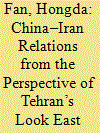

|
|
|
|
|
| Summary/Abstract |
In recent years the Iranian government has emphasised its Look East approach. As a diplomatic choice, the Look East approach has also aroused different understandings among Iranian scholars and in this context, China has received more attention from Iran. For different reasons, many countries have tracked and observed Iran's Look East approach and China-Iran relations. At present, there are many negative perceptions about the Look East approach and Sino-Iranian relations in Iran and the international community. So far, China has made very few official comments on Iran's Look East approach, and this is essentially the case with Chinese scholars and media. China is very concerned about whether Iran's Look East approach is an act of political expediency or a strategy. Some of Iran's actions in the past few years have partially proved the necessity for China to be so suspicious. Although there are some negative views of China in Iran, Beijing should still pay more attention to deepening relations with Tehran. Even if Iran's Look East approach is not a long-term strategy, it is no longer just an expedient measure to deal with Western sanctions. China must be an important goal of Iran's multilateral diplomacy. China and Iran, which need each other, urgently need to increase political mutual trust.
|
|
|
|
|
|
|
|
|
|
|
|
|
|
|
|
| 3 |
ID:
087512
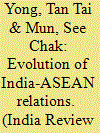

|
|
|
|
|
| Publication |
2009.
|
| Summary/Abstract |
Relations between India and Southeast Asia have deep historical
roots. For centuries, trade and human migration traversed the Bay of
Bengal and the Indian Ocean connected maritime Southeast Asia and
the Indian subcontinent in complex networks that were sustained by
commerce, culture, and community. As a consequence, large parts of
Southeast Asia came under profound Indian influences. British imperialism
strengthened these networks by bringing the subcontinent and
the territories to its east under the colonial sphere of influence, underpinned
largely by trade and commerce. In the 1940s, as India headed
towards political independence, Jawaharlal Nehru had looked to
Southeast Asia as a region whose history, fate, and destiny are somewhat
linked with India's. Great civilizations had once flourished in
these regions, but their destinies had been suppressed by long periods
of colonial rule. He believed that the world had been transformed by
the Second World War, and in the twilight of European imperialism
and the emergence of Asian nationalism, the peoples of India and
Southeast Asia would rediscover their own identities. As the first
Asian country to achieve independence from European colonial rule,
India was regarded by Southeast Asian nationalists, most of whom
had aspirations to follow in India's footsteps, as a natural leader of
an impending free and resurgent Asia.
|
|
|
|
|
|
|
|
|
|
|
|
|
|
|
|
| 4 |
ID:
179351
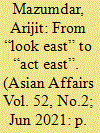

|
|
|
|
|
| Summary/Abstract |
In 1991, India's Prime Minister P.V. Narasimha Rao outlined the ‘Look East' policy, designed to address India's neglect of the Southeast Asian region during the Cold War period. The purpose of the Look East policy initially was to build closer economic and cultural ties with the countries of the region and with ASEAN in particular. The current Modi administration's new ‘Act East' policy has sought to expand these ties to include deeper security cooperation and defense partnerships as well. In addition, the new policy focuses on building ties with countries in the wider Asia-Pacific region, including Australia, New Zealand, Japan, and South Korea. The new policy is more than an exercise in rebranding. The primary goals behind the Act East policy are both to promote India's economic growth and development and respond to China’s rise and expanding influence in the region. However, India needs to be mindful about the challenges associated with the implementation of this policy.
|
|
|
|
|
|
|
|
|
|
|
|
|
|
|
|
| 5 |
ID:
143993
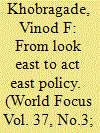

|
|
|
|
|
| Summary/Abstract |
India’s recent foreign policy has been under marking a paradigmatic shift especially by proactive ‘alignment’ with the world powers especially the USA, France, Japan and others. India’s new leadership has learnt the need of new ingredients in its foreign policy with the changing circumstances of the international political equations and more importantly to accomplish its national interests in terms of economy, security and technology that emerged as pre-conditions towards becoming India as one of the leading powers in the world.
|
|
|
|
|
|
|
|
|
|
|
|
|
|
|
|
| 6 |
ID:
076685
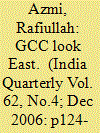

|
|
|
| 7 |
ID:
147861
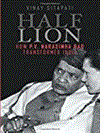

|
|
|
|
|
| Publication |
Gurgaon, Penguin Books India Pvt Ltd, 2016.
|
| Description |
391p.hbk
|
| Standard Number |
9780670088225
|
|
|
|
|
|
|
|
|
|
|
|
Copies: C:1/I:0,R:0,Q:0
Circulation
| Accession# | Call# | Current Location | Status | Policy | Location |
| 058833 | 923.2/SIT 058833 | Main | On Shelf | General | |
|
|
|
|
| 8 |
ID:
140629
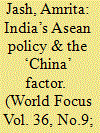

|
|
|
|
|
| Summary/Abstract |
India’s relations with Southeast Asia is one of the promising relations in Asia and that of the 21st century. The relationship is endowed with strong civilizational and cultural links of the past to that of its strategic links in the present-being global economic players, Asian regional giants and most importantly, partners with varied commonality of interests ranging from trade to that of security- both traditional and non-traditional concerns. The end of the Cold War brought about structural changes in the international system that led India to adopt new orientations in its foreign policy. Under this shift, India adopted ‘Look East’ policy in 1992 which resulted into a strategic shift in India’s perspective- bringing Southeast Asia closer to its foreign policy orbit. But with the changes in the global politics as a result of ‘China’s rise’, this relationship too is having a causal effect on its geo-political and security landscape. This ‘China factor’ has thereby elevated the paradigm of India-ASEAN relations to that of a ‘Strategic Partnership’ from being ‘Dialogue Partners’.
It is in this context that the paper examines India’s relations with ASEAN under the strategic interests and concerns. It explores the pertinent aspects that influence the India-ASEAN relations and thereby, argues that India’s policy towards ASEAN has witnessed a shift from just ‘looking towards east’ to that of ‘engaging with the east’.
|
|
|
|
|
|
|
|
|
|
|
|
|
|
|
|
| 9 |
ID:
138023
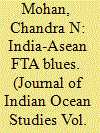

|
|
|
| 10 |
ID:
140610
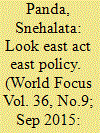

|
|
|
|
|
| Summary/Abstract |
CMLV are promising economies for intensive engagement. But challenges are many .The present approach is in sync with their aspirations as well as India’s endeavour to knock the Asian Century into shape.A new dynamism characterizes India’s foreign policy through increased frequency of interactions with small ,medium and great powers of the world including those which were not in the diplomatic basket and those which had slipped out of it .Reinvigorated relationships reflect the personality of our leaders managing foreign affairs, their ability to replace diplomatic jargon with an informal style for interaction and allowing enough space for operationalisation of soft power buttressed by a clear electoral mandate .The geo-economic realities coupled with historical and cultural affinity as well as gestures to respect sovereign equality of nations despite their size and resources have enlivened an environment of trust in most of the neighbouring countries .This is reinforced by India’s response to disaster management , prompt action to fulfill promises and resolution of some unsettled bilateral problems. External relationship has immense repercussion on domestic issues particularly economic growth and the recent initiatives evince genuine effort to achieve this objective.
|
|
|
|
|
|
|
|
|
|
|
|
|
|
|
|
| 11 |
ID:
104612
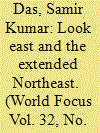

|
|
|
| 12 |
ID:
105696
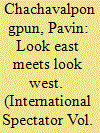

|
|
|
|
|
| Publication |
2011.
|
| Summary/Abstract |
India has been eager to expand its economic networks with Southeast Asia, one of the most vibrant segments of the world economy, accounting for a large share of global exports. In addition to the economic links required to feed India's fast growing economy, greater cooperation and integration is considered a way of promoting development in India's northeast as well as the less-developed Southeast Asian countries. While some fear growing rivalry in the area between India and China, their growing commercial interests are more likely to lead to enhanced cooperation, given the need to build up a peaceful environment to protect their business interests in the region. The competition could also prove beneficial to Southeast Asia itself, spurring economic openness and competition.
|
|
|
|
|
|
|
|
|
|
|
|
|
|
|
|
| 13 |
ID:
192543
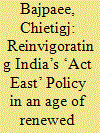

|
|
|
|
|
| Summary/Abstract |
The year 2022 marks three decades of India’s ‘Look East’ Policy (renamed the ‘Act East’ Policy in 2014). The policy emerged in the aftermath of the Cold War amid efforts by New Delhi to revive the importance of Southeast Asia (and later East Asia and the broader Indo-Pacific region) in India’s foreign policy agenda. While the policy has proven to be resilient as a core component of India’s foreign policy agenda, looking ahead it faces three key challenges: domestically, India’s reform agenda failing to match the country’s foreign policy aspirations; regionally, the principle of ‘ASEAN centrality’ coming under growing scrutiny; and globally, an international order in flux amid a more pronounced rivalry between the United States and China (which has been exacerbated by the Russian invasion of Ukraine). Addressing these issues will be key to maintaining the relevance of India’s ‘Act East’ Policy as it enters its next phase.
|
|
|
|
|
|
|
|
|
|
|
|
|
|
|
|
|
|
|
|
|